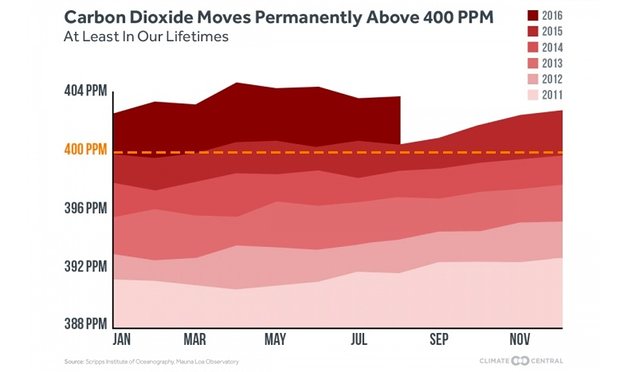Carbon dioxide in the atmosphere has increased: 400 ppm

In September we stepped over the red line: the concentration of carbon dioxide in the Earth’s atmosphere increased to 400 parts per million . Over 200 years of industrial development, the concentration of carbon dioxide in the atmosphere has risen from 280 to 400 parts per million. Climatologists believe that CO 2 in the atmosphere will never be less.
Now it is believed that the increase in carbon dioxide levels due to human activity. The increase in CO 2 concentration coincided with the onset of the industrial revolution. Since then, this figure has only increased, and in the near future is not going to decline. Proof of this can be the fact that in September in the Earth’s atmosphere, usually, the minimum level of carbon dioxide per year. But in 2016, CO 2 did not decrease in September.
Data on the concentration of carbon dioxide in the atmosphere of the Earth provide several organizations. The main monitoring center is the Mauna Loa Observatory . It is located on the southern slope of the mountain of one of the Hawaiian islands. Information obtained by the staff of the observatory is used in global monitoring of the state of the atmosphere and in analyzing problems that are associated with global warming.
“Is it possible that in October 2016 the CO 2 concentration will fall below 400 ppm? No, that is very unlikely, ” says Ralph Keeling, lead carbon dioxide monitoring specialist at the Scripps Institute of Oceanography. A slight negative trend is still possible, the scientist believes, but a decrease in carbon dioxide levels can only be short-term.
')
The causes of negative dynamics may be different. For example, the observatory of Mauna Loa in August of this year recorded a fall in CO 2 below 400 ppm. This is explained by the fact that in August in the area of the Hawaiian Islands there was a hurricane, which caused a decrease in carbon dioxide concentration. In general, according to climatologists, we already live in a world of "400 parts per million", and in the near future the situation will not change. What consequences can this have for a person?
Carolyn Snyder of Stanford University (USA) conducted work on analyzing the temperature on Earth over a period of two million years. The work compared temperature dynamics and changes in the concentration of carbon dioxide in the atmosphere. As it turned out, the Earth's climate is even more sensitive to carbon dioxide than previously thought. Snyder claims that in the next thousand years the temperature will rise by several degrees at once. She outlined her findings in an article published in the journal Nature .
To track the dynamics of temperature on Earth over a period of 2 million years, Snyder used a specific technique, where it is necessary to estimate the ratio of magnesium and calcium isotopes in sedimentary rocks. This method can only be used to assess long-term changes in temperature parameters on the planet.
As it turned out, the last five thousand years have become the warmest over a period of 120,000 years. True, the temperature peak fell just in the first 5000 years of the specified time period. Then the average annual temperature was about 3.5 ° C higher than now. Warmer on Earth was only 2 million years ago, when the average temperature was about + 16 ° C. Now the average annual temperature on Earth is + 14 ° C. Snyder has built a scale based on the concentration of carbon dioxide. If we use the method proposed by Carolyn Snyder, it turns out that at a CO 2 level of 560 ppm, the average annual temperature should rise from + 14 ° C to + 23 ° C.
The increase in carbon dioxide concentration over the past 200 years from 280 to 400 ppm should lead to an increase in the average annual temperature on Earth of about + 5 ° C. So far, scientists are talking about the difference with the pre-industrial period of only + 1 ° C. Snyder claims that the reason is the inertia of the planet’s climate. After some time, the temperature will rise. And even if the concentration of CO 2 remains at the current level, after 1000 years, the average annual temperature on Earth will rise by the predicted + 5 ° C.

Industry - the main factor in climate change on the planet (Source: Kevin Frayer / Getty Images)
Snyder says that a gradual increase in temperature will affect the dynamics of the currents of the World Ocean. These currents, according to the scientist, control 100,000-year-old climate variations. If a person “presses” on the climate too much, the climatic cycles of our planet can be broken. True, it is not yet possible to predict what impact a person will have on currents in the near foreseeable future.
The topic of climate research is one of the most controversial in science. Supporters of the theory of anthropogenic global warming (AGP) have many opponents. Several years ago, a network of documents was stolen from the Climatology Research Unit (CRU) of the University of East Anglia (University of East Anglia, UEA). Opponents of the AGP theory have argued that the leak confirms the assumption that climatologists are distorting the results of observations in order to confirm global warming. And although the verification of the Climatgate participants showed their innocence, some experts still have doubts about the reality of global warming.
It is difficult to say how the temperature dynamics of the climate will change, and also the concentration of CO 2 in the Earth’s atmosphere will change. About this, scientists and ordinary people will find out only after some time.
Source: https://habr.com/ru/post/397827/
All Articles